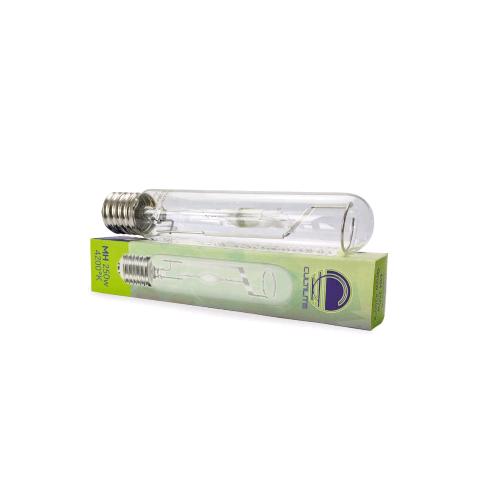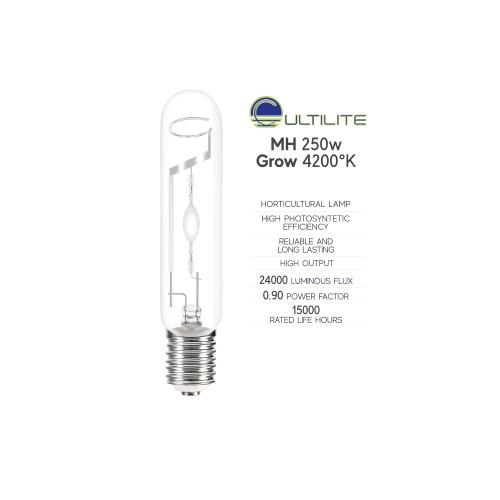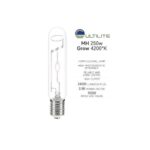CULTILITE – MH 250W – 4200°K
Metal halide (MH) lamps are widely used for the growing of plants. The popularity of the 250W metal halide (MH) lamps is growing rapidly in comparison to other common high-intensity discharge (HID) lamps, as well as to the 400W and 175W MH types. CULTILITE – MH BULB 250W – GROW 4200°K provide UV-B and UV-C to simulate morning sunlight in indoor tree cultivation more closely than other filters. High-pressure sodium (HPS) fixtures with UV-B transmitting filters have too little UV-B output for morning sunlight simulation. It was also found that simulated morning sunlight improves indoor white pine seedling growth and stability over the commercially implemented high-pressure fixtures. Since high UV-B output is a requirement for MH radiance produced by indoor morning sunlight simulators, selecting the 250W MH lamps will block excessive UV-B and UVC radiance limits. Local greenhouse growers also use 250W MH lamps for supplemental lighting. The ceramic arc tube of the Cultilite lamp delivers a broad, bright spectrum of light that contains a high portion of ultraviolet and blue light, which is especially advantageous when illuminating young plants. The blue light is absorbed by chlorophyll and carotenoids and triggers a natural defense mechanism within the plants, limiting the damaging effects of molds, a common problem in the growth of commercial crops.
Artificial lighting plays a key role in the indoor production of high-quality plants and other crops. Most large greenhouses and a large number of smaller greenhouse operations use artificial lighting to assist in the growth of plants during low-light periods or to assist high-light crops during periods of sunny or cloudy weather. The high-pressure metal halide lamp has close similarities to the high-pressure sodium and mercury lamps. Indeed, the first metal halide lamps available can be easily converted from sodium lamps. High-intensity discharge lamps operate on the same principles. The merits and drawbacks of this technology stem from the triggering of arc discharge in a clean environment. Conductivity also occurs in a clean environment because of the transfer of high-temperature free electrons, the quantum mechanical nature of the physics. Distinct pressure effects in the thermal reattachment of electrons to metal cations using the collision with a free electron are not seen until pressures exceed certain levels such that high-brightness X-ray sources are needed to detect them. High-voltage electrodes are installed in a high-pressure discharge lamp, but they are designed such that a glow discharge atmosphere is maintained while each arc is initiated. Once established, the ballast control mechanisms are most carefully designed to make the arc shine so that the lifetime of a doped carbide cathode determines the overall lamp life.
Importance of Blue Light in Vegetative Growth
The balance of visible radiation wavelengths is a significant determinant of vegetative growth. Blue light in CULTILITE – MH BULB 250W – GROW 4200°K regulates several aspects of plant vegetative growth, such as stem elongation, morphological structure, leaf area, and leaf thickness. These effects indicate the importance of blue light as a vital environmental factor influencing vegetative growth. Blue light is a significant environmental element influencing vegetative growth and development in most studies, with the wavelength of blue lighting in the range of 420-460 nm. It allows optimal leaf area and photosynthetic parameters by light transmission through the upper leaves. Although blue light has no significant effect on plant photosynthesis, it still facilitates chlorophyll synthesis, with enhanced synthesis of photosynthetic pigments, driven by the increased intake of CO2 in photosynthetic carbon assimilation.
As the blue light increases, red/far red decreases, causing an increase in concentration of certain compounds. The effects of far red and ultraviolet light differ by species; they enhance stem elongation in some plants. Since blue light has a pronounced stimulatory effect on stem elongation, different regions of the spectrum have a pronounced effect on this response, which clearly points to the involvement of specific photoreceptors.
Applications in Indoor Plant Growth
In addition to studying the morphological effect of using different artificial light sources or spectral distributions on various green, red, and leafy plant types such as lettuce, cabbage, spinach, and tomato in growth chambers, some of the physiological and biochemical aspects such as chlorophyll fluorescence and anthocyanin content, plant growth, and nutrient uptake are also usually investigated. Until now, the growth chamber using fluorescent or incandescent lamps is more popular in the experiment of plant growth than others due to the lower price, high efficiency, and the suitable spectral range for plants.























Reviews
There are no reviews yet.